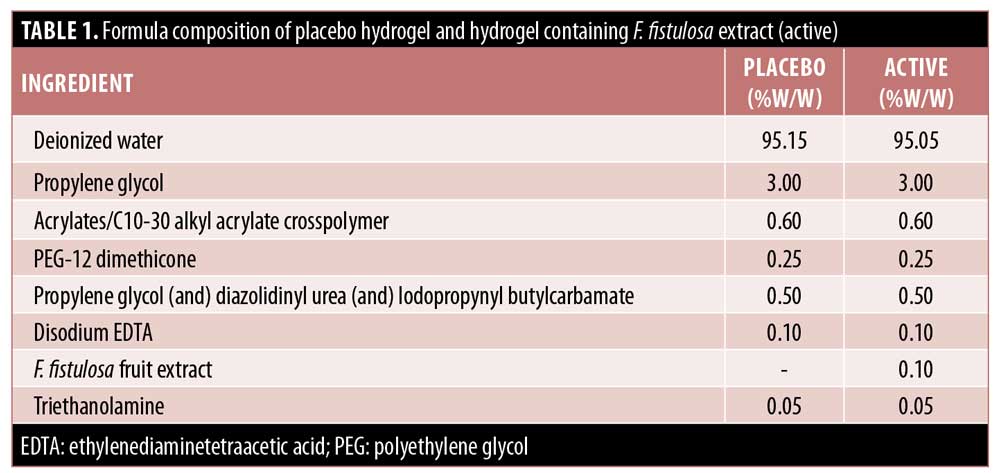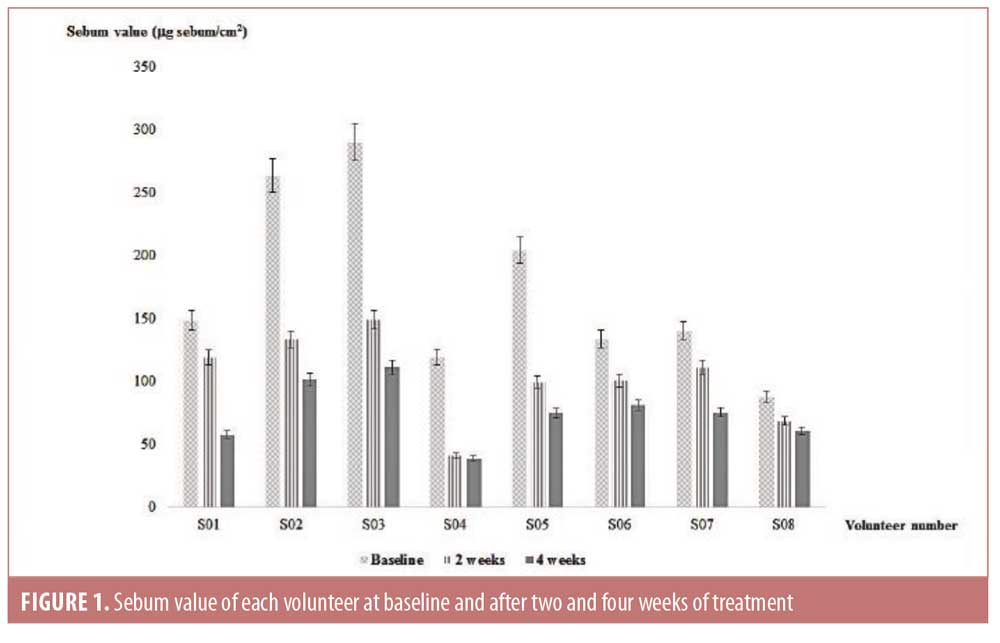 J Clin Aesthet Dermatol. 2021;14(7):42–45.
J Clin Aesthet Dermatol. 2021;14(7):42–45.
by Naphatsorn Ditthawutthikul, PhD; Pawida Saithong, BSc; Phichamon Thawee, BSc; Sarayut Rakarcha, PhD; and Anittaya Kanghae, PhD
Drs. Ditthawutthikul, Saithong, and Thawee are with the School of Cosmetic Science at Mae Fah Luang University in Chiang Rai, Thailand. Dr. Ditthawutthikul is also with the Phytocosmetics and Cosmeceutical Research Unit, School of Cosmetic Science at Mae Fah Luang University in Chiang Rai, Thailand. Dr. Rakarcha is with the Queen Sirikit Botanic Garden at The Botanical Garden Organization in Chiang Mai, Thailand. Dr. Kanghae is with the Program in Science, Faculty of Science and Technology at Phuket Rajabhat University in Phuket, Thailand.
FUNDING: No funding was provided for this article.
DISCLOSURES: The authors report no conflicts of interest relevant to the content of this article.
ABSTRACT: Background. Tannins are considered an important phytochemical used in cosmetics and cosmeceuticals and are well-known for their astringent and antioxidant properties. Ficus fistulosa is a plant that grows in the Southern part of Thailand. Its fruits have an astringent taste, which might correlate with the presence of tannins.
Objective. We sought to evaluate the efficacy of a hydrogel containing F. fistulosa extract for controlling sebum.
Methods. First, the extract of F. fistulosa fruit was evaluated for its tannin content and astringent activity in vitro. Then it was formulated into a hydrogel in different concentrations. After, the safety and sebum-control efficacy of this hydrogel was tested in 10 healthy volunteers. The safety of this hydrogel was evaluated in volunteers using a closed patch test.
Results. The results of the first part of the study indicated that F. fistulosa extract contained 0.0359±0.0003mg of tannic acid equivalent per gram of extract, and its astringent activity was 87.45%±1.76%. When formulated into hydrogels of different concentrations, the results showed that the hydrogel containing 0.1% w/w had the highest stability profile. No irritation or allergy was observed. Separately, after usage twice per day for 28 consecutive days, the sebum content of the volunteers was decreased by -54.36%±13.71% relative to baseline.
Conclusions. The results from this study suggest that F. fistulosa fruit extract might be an effective active ingredient for use by the cosmetic and cosmeceutical industry.
Keywords: Astringent, Ficus fistulosa, hydrogel, seborrhea, tannins, topical preparation
Seborrhea, or oily, skin is a common and undesirable condition that affects both men and women alike from puberty to about 60 years of age.1 It results from overactivity of the sebaceous gland and usually leads to oily and shiny skin.2 Sebum is composed mostly of fatty acids, triglycerides, wax esters, and squalene and minorly of cholesterol esters. Although sebaceous lipids have antimicrobial activity, excessive sebum production causes acne.1,3
Ficus fistulosa is a plant in the Moraceae family, the same family and genus as Ficus carica L., or the edible fig. It grows in several tropical countries, including Thailand. F. fistulosa is a tree that bares an edible fruit.4 F. fistulosa has several local names in Thailand, including ching, ching khaao, and ching baan. The unripe fruits are green in color, with a thumbnail size and spherical shape with some flattening on top and bottom. It has an astringent taste, suggesting the presence of tannins. Previous studies have found that F. carica, a plant that belongs to the same genus, has high antioxidant activity and total tannin content.5 However, little information about F. fistulosa fruit is currently available.
The term “astringent” has been used to describe food products, such as red wine, tea, coffee, and unripe fruit.6 Tannins are well-known for their strong antioxidant activity, but another interesting attribute is their astringency. In cosmetics, tannins have astringent activity, which can bind to skin proteins and form complexes on the skin surface that might reduce the amount of sebum secretion.7 Tannins in plants can be classified into two groups; hydrolyzable tannins and condensed tannins or proanthocyanidins.6,8
With this study, we sought to investigate the tannin content and in-vitro astringent activity of F. fistulosa fruit, formulation of a hydrogel, and evaluation of in-vivo safety and sebum-control efficacy in healthy volunteers.
Methods
Plant materials. Fresh F. fistulosa fruits were purchased from a local market in Suratthani province, Thailand, in September 2015. The identity of the fruits was confirmed by a botanist at Phuket Rajabhat University in Phuket, Thailand. The scientific name F. fistulosa Reinw. ex Blume was given.
Chemicals. The chemicals and reagents used in this experiment were of an analytical grade and purchased from local distributors in Thailand. The ingredients for formulating and preparing the hydrogel placebo and hydrogels containing F. fistulosa extract were of a cosmetic grade and purchased from local distributors in Thailand.
Ferric chloride (FeCl3), Folin-Ciocalteu reagent, sodium carbonate (Na2CO3), hemoglobin (Sigma-Aldrich, St. Louis, Missouri), tannic acid (Tokyo Chemical Industry, Tokyo, Japan), and 95% ethanol (Avantor Performance Materials, Radnor, Pennsylvania) were of analytical grade.
Extraction of F. fistulosa fruit. The fruits of F. fistulosa were cleaned with tap water and excess water was drained in a sieve at room temperature. Then, the fruits were pulverized with an electric mixer before being macerated with 95% ethanol in an amber glass bottle for seven days. The extracts were concentrated under controlled pressure and temperature using a rotary evaporator (Eyela, Tokyo, Japan). Obtained extract was kept at 4°C until used.
Phytochemical screening for tannins. Phytochemical screening for tannins was performed according to the method described by Zohra et al.9 A ferric chloride test solution was prepared by dissolving 0.9g of FeCl3 in 10mL of deionized (DI) water. Then, the extract was diluted in distilled water at a concentration level of 0.1% w/w. After that, three drops of FeCl3 test solution were introduced into the diluted extract solution. A dark green, blue, or black discoloration indicated the presence of tannins.
Determination of total tannin content. Total tannin content (TTC) was determined according to the method described by Kumar and Chaiyasut.10 First, 100µL of F. fistulosa extract in ethanol was mixed with 100µL of deionized water before the addition of 1mL Folin-Ciocalteu reagent (0.2 N). Then, 800µL of a 7.5% Na2CO3 solution was added. After incubating for two hours, the absorbance of the mixture was read at 725nm using an ultraviolet-visible spectrophotometer (Biochrom, Cambridge, England). Tannic acid was used as a standard. The TTC of each sample was expressed as micrograms of tannic acid equivalent per gram of extract (ug TAE/g E).
Evaluation of in-vitro astringent activity. The astringent activity of the extracts was analyzed according to the method described by Kumar and Chaiyasut.10 1mL of 1mg/mL of swine hemoglobin in DI water was mixed with 1,000uL of the 1mg/mL solution of F. fistulosa extract in DI water using a vortex mixer. The mixture was further centrifuged at 1,000 × g at 25°C for 10 minutes. A supernatant was collected and measured for ultraviolet-visible absorbance at 407nm. Tannic acid (1mg/mL) was used as a positive control and DI water was used as a negative control. Astringent activity was calculated by the following equation:
In this equation, Actrl is the absorbance of the control (hemoglobin in deionized water) and Asam is the absorbance of the sample.
Preparation of placebo hydrogel and hydrogel containing F. fistulosa extract. Various types of gelling agent were previously screened for appropriateness in the hydrogel formula (results not shown). In this study, acrylates/C10-30 alkyl acrylate crosspolymer (Carbopol® Ultrez-21; The Lubrizol Corporation, Wickliffe, Ohio) was found to be the most appropriate gelling agent, and was selected for use in the hydrogel formula. A combination of propylene glycol (and) diazolidinyl urea (and) iodopropynyl butylcarbamate (Liquid Germall™ Plus; Ashland Specialty Chemical, Wilmington, Delaware) was used as an antimicrobial preservative. The formula compositions of the placebo hydrogel and hydrogel containing F. fistulosa extract are shown in Table 1.

Evaluation of safety and in-vivo sebum controlled efficacy. The study was performed at Mae Fah Luang University in Chiang Rai, Thailand, in accordance with ethical principles of the Declaration of Helsinki. The study protocol was reviewed and approved by the ethics committee of Mae Fah Luang University in Chiang Rai, Thailand (approval no. REH-59100). Ten healthy female volunteers aged between 20 and 25 years old were included. Subjects were included if they had oily skin, were able to cease use of all other skin care products and use only the tested hydrogel, their routine sunscreen products, and makeup for 28 days, had no history of cosmetic allergy, and were able to visit Mae Fah Luang University in Chiang Rai, Thailand, for skin parameter measurement. The main exclusion criteria were dry skin, presence of inflammatory acne and/or another skin disease, and hypersensitivity to the ingredients used in the hydrogel.
The safety profile of the most appropriate formula was performed using an epicutaneous closed patch test.11 All procedures were described to all volunteers and informed consent statements were signed prior to conducting the test. Twenty microliters of each sample, including 2% w/w of sodium lauryl sulfate solution as a positive control, DI water as a negative control, the hydrogel placebo, and the hydrogel containing extract, was placed on the skin using a Finn® chamber (Smart Practice, Phoenix, Arizona) and kept in position for 24 hours. Then, the patch was removed and the skin reaction was assessed at 30 minutes after patch removal. The skin reaction was graded for erythema and edema as follows: 0=no reaction, 0.5=very slight reaction, 1.0=slight reaction, 2.0=obvious reaction, and 3.0=important reaction. The mean irritation index (MII) of each sample was then calculated according to the following equation:

In this equation, sigmaIS24 was the summation of irritation and edema scores at 24 hours and n was the number of subjects included in this study.
The degree of irritation was categorized based on the MII value as nonirritation (MII<0.2), slight irritation (0.2<MII<0.5), moderate irritation (0.5<MII< 1), or strong irritation (MII>1).11
Volunteers who passed the irritation and allergy tests were further included for additional investigation and were asked to use only their own routine cleansing product, sunscreen, and makeup products during the study; other skincare products were prohibited. The tested product was applied to the whole face after cleansing twice per day (morning and evening) by the study subjects at home for 28 days of treatment. The area around the eyes and mouth were omitted. Measurement of sebum content was conducted at baseline (Day 0), Day 14, and Day 28 after the treatment period.
Prior to skin measurement, participants were asked to wash their face with their own cleansing product with tap water. The face was then dried with a soft towel. After that, they were asked to stay in a room with a controlled temperature (21°C–25°C) and relative humidity (45%–60%) for 60 minutes before the beginning of measurements. The casual sebum level on the forehead was examined by using Sebumeter® SM 815 (Courage+Khazaka, Köln, Germany). An opaque plastic tape on this device was pressed onto the skin for 30 seconds with a constant pressure by the same researcher to collect the sebum before analysis using the software provided with the device. The amount of sebum was expressed as ug of sebum/cm2 skin.
Percent change in sebum content of each volunteer was calculated by using the following equation:

In this equation, Sbefore was the sebum content at baseline and Safter was the sebum content at a specific time (Day 14 or Day 28 after treatment).
Statistics. All data were reported in mean ± standard deviation values of triplicated experiment. The significance of differences was evaluated by using the Student’s t-test (paired t-test by comparison between before treatment and after treatment) at the 95% confidence level using the Statistical Package for the Social Sciences version 17.0 (IBM Corporation, Armonk, New York). A p-value of less than 0.05 indicated statistical significance.
Results
In this study, obtained F. fistulosa fruit extract occurred as a dark brown, viscous semi-solid, with a characteristic odor. The percent yield of F. fistulosa fruit extract was 2.44% based on the fresh weight of the fruits.
Tannins were preliminarily screened using ferric chloride test solution. After the addition of the test solution, F. fistulosa fruit extract changed from a light orange solution to a dark blue-green solution with some precipitate. This indicated the presence of tannin in F. fistulosa fruits.
Tannins were quantitatively determined by using Folin-Ciocalteu reagent, which is a mixture of tungstates and molybdates in the form of a solution that works on the oxidation-reduction reaction. The reduction of the mixture by the phenolic compound resulted in the appearance of a blue color under alkali conditions.12 The total tannin contents of F. fistulosa fruit extract was 35.9±0.0ug TAE/g E.
In-vitro astringent activity of the extract was evaluated using a hemoglobin precipitation technique, based on the principle that tannins can induce precipitation of protein. Hemoglobin is a chromoprotein with a red color. This color can be measured by using an ultraviolet-visible spectrophotometer. When hemoglobin was precipitated with tannins and removed from the solution, the color disappeared, which led to a reduction in the absorbance. In this study, 1% w/w of F. fistulosa fruit extract had an astringent activity of 87.45%±1.76%, while tannic acid (a positive control) had astringent activity of 101.3%±0.4%.
In the next part of the study, hydrogel was prepared using acrylates/C10-30 alkyl acrylate crosspolymer as a gelling agent (Table 1). The placebo and tested hydrogels shared the same formula composition, except for the presence of F. fistulosa extract (0.1% w/w).
In the safety test, nine volunteers completed the epicutaneous closed patch test. MII scores are shown in Table 2. One volunteer was excluded from the study due to patch-adhesive allergy. No irritation, hypersensitivity, or delayed type of hypersensitivity to the hydrogel containing F. fistulosa fruit extract was observed in any volunteers.

In the in-vivo sebum control efficacy investigation, eight volunteers completed the test. One volunteer withdrew due to acne formation. After 14 and 28 days of application, the sebum levels of volunteers were significantly (p<0.05) and highly significantly (p<0.01) decreased, respectively, relative to at baseline. The changes in the sebum levels of each subject are shown in Figure 1. The mean percentage of change in sebum content with the hydrogel containing F. fistulosa fruit extract was -54.36%±13.7% on Day 28. Subjective evaluation by volunteers indicated that their faces were not as oily as before they participated in the test.

Limitations. Our study is limited by the small sample size and lack of control in the efficacay portion of the study. For a more precise evaluation of the efficacy, a split-face study and/or placebo-controlled study may be beneficial in supporting our initial findings. An increased number of study participants might also be useful for obtaining clearer results.
Conclusion
The results from this study suggest that F. fistulosa fruit extract obtained by maceration technique with 95% ethanol contains tannins as an active phytochemical. In-vitro astringent activity of this extract was observed. A hydrogel containing this extract triggered no irritation, allergy, or delayed-type hypersensitivity as evaluated by epicutaneous closed patch test. The hydrogel containing F. fistulosa fruit extract was highly effective in reducing the measured sebum levels of the study subjects over a period of 28 days. These results suggest that this extract might be a potential candidate as a sebum-control agent in cosmetics and cosmeceuticals. Further studies with a greater number of participants and/or split-face, placebo-controlled studies might provide a better understanding and clearer results regarding this extract.
Acknowledgments
The authors would like to express their sincere gratitude to all of the volunteers who participated in this study. N. D., P. S., and P. T. would like to thank Mae Fah Luang University and School of Cosmetic Science for support with the materials, equipment, and instruments used in this study.
References
- Ali A, Akhtar N, Khan MS, et al. Effect of Moringa oleifera on undesireble skin sebum secretions of sebaceous glands observed during winter season in humans. Biomed Res. 2013;24(1):127–130.
- Peirano RI, Hamann T, Düsing HJ, et al. Topically applied L-carnitine effectively reduces sebum secretion in human skin. J Cosmet Dermatol. 2012;11(1):30–36.
- Pappas A. The relationship of diet and acne: a review. Dermatol Endocrinol. 2009;1(5): 262–267.
- Pothasin P, Compton SG, Wangpakapattanawong P. Riparian Ficus tree communities: The distribution and abundance of riparian fig trees in Northern Thailand. PloS One. 2014;9(10):e108945.
- Harzallah A, Bhouri AM, Amri Z, et al. Phytochemical content and antioxidant activity of different fruit parts juices of three figs (Ficus carica L.) varieties grown in Tunisia. Ind Crop Prod. 2016;83:255–267.
- Ashok PK, Upadhyaya K. Tannins are astringent. J Pharmacog Phytochem. 2012;1(3):45–50.
- Son DH, Nam, MH, Hong CO, et al. 5alpha-Reductase inhibitory effect and astringent activity of green apple rind extract on human keratinocytes and fibroblast cells. Biosci Biotech Biochem. 2013;77(4):714–721.
- Li PM, Du GR, Ma FW. Phenolics concentration and antioxidant capacity of different fruit tissues of astringent versus non-astringent persimmons. Scientia horticulturae. 2011;129(4):710–714.
- Zohra SF, Meriem B, Samira S, et al. Phytochemical screening and identification of some compounds from mallow. J Nat Prod Plant Resour. 2012;2(4):512–516.
- Kumar N, Chaiyasut C. Health promotion potential of vegetables cultivated in Northern Thailand: A preliminary screening on tannin and flavonoid contents, 5alpha-reductase inhibition, astringent activity and antioxidant activities. J Evid-Based Complem Altern Med. 2017;22(4):573–579.
- Kanlayavattanakul M, Lourith N, Chaikul P. Jasmine rice panicle: A safe and efficient natural ingredient for skin aging treatments. J Ethnopharmacol. 2016;193:607–616.
- Jadhav AP, Kareparamban JA, Nikam PH, Kadam VJ. Spectrophotometric estimation of ferulic acid from Ferula asafoetida by Folin-Ciocalteu’s reagent. Der Pharmacia Sinica. 2012; 3:680–684.

